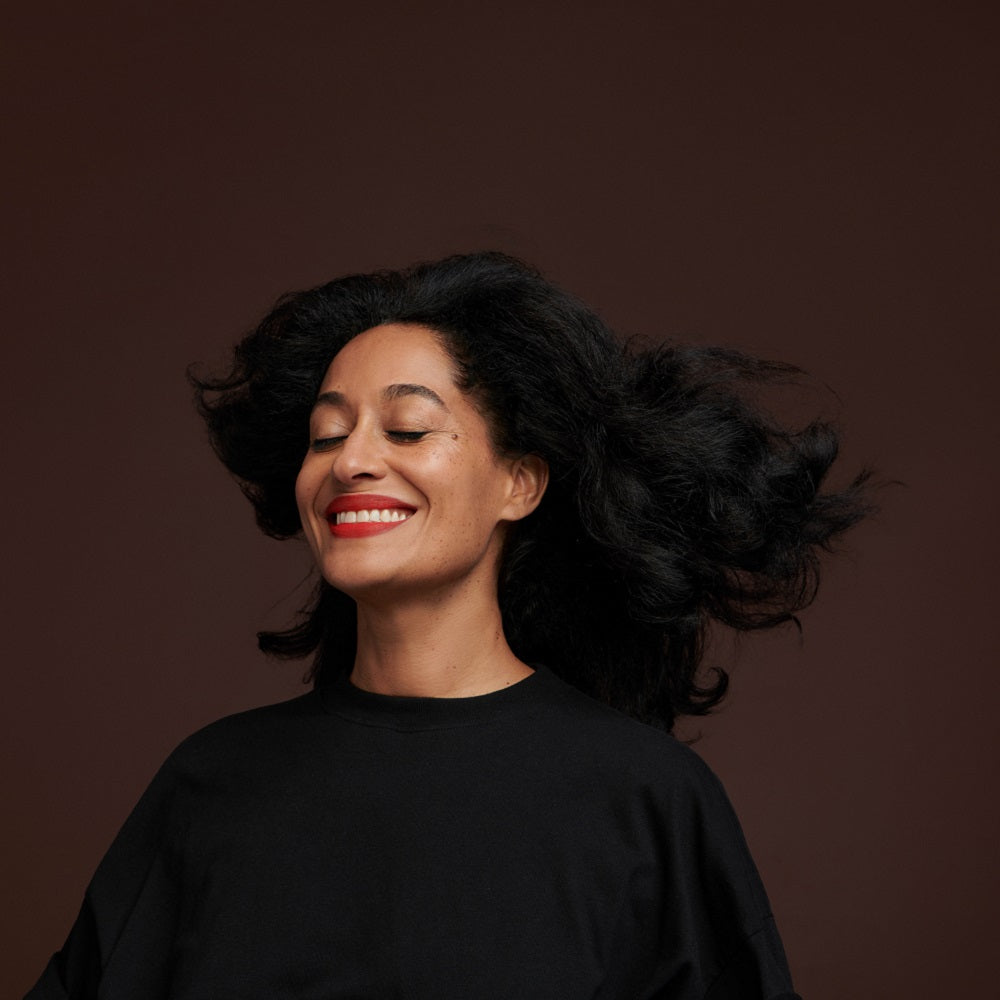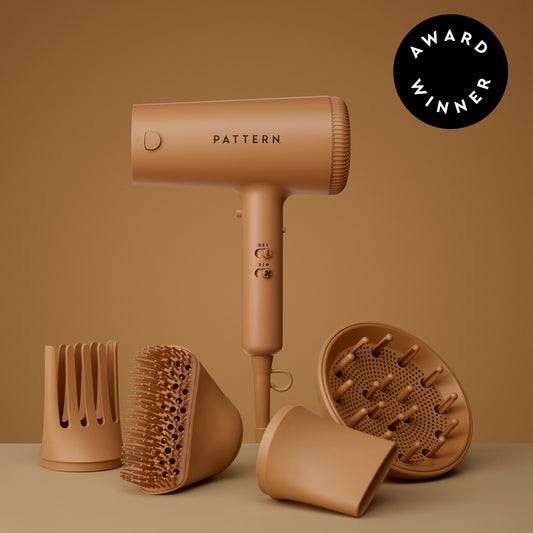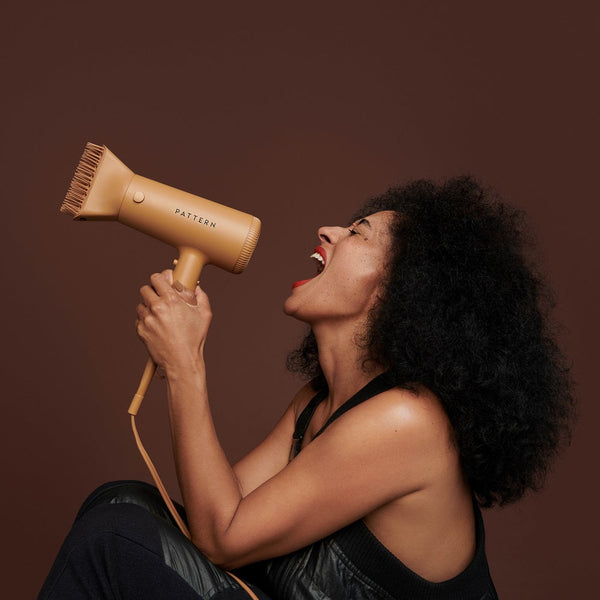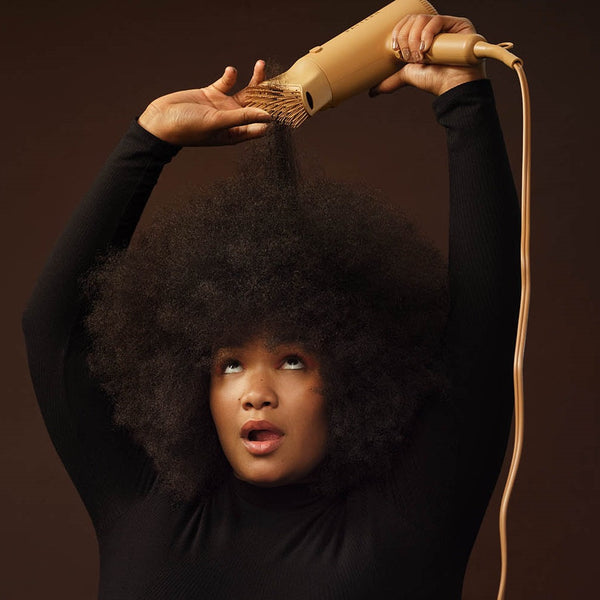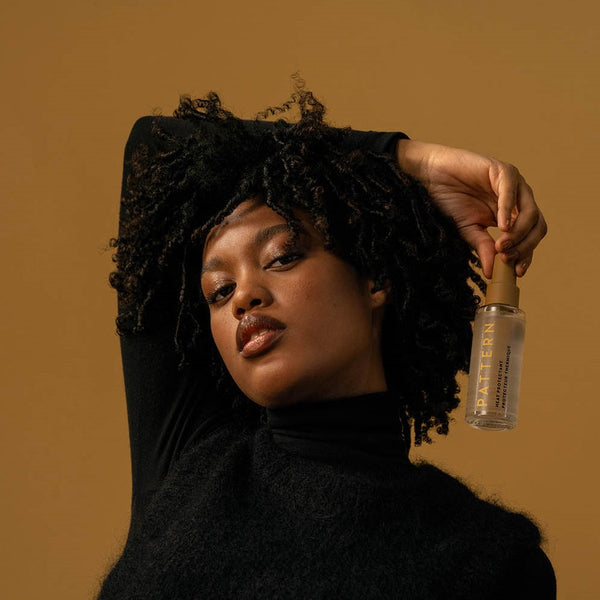We’ve all been there: You take your time in the morning, smoothing your curls into a chic, loosened style…but within a few hours, your sleek strands have returned to their naturally textured selves. It leaves you longing for a way to achieve loosened curls that last—without turning to chemical relaxers that can permanently weaken your hair.
Enter heat hair training. When you heat train hair, you encourage your strands to hold straighter styles longer, even when exposed to humidity.
Heat training natural hair requires a bit of know-how to avoid ending up with heat damaged curls. All you need is a little extra TLC, & our guide to how to heat train hair.
Step 1: Understand Heat Training for Natural Hair
Heat training refers to repeatedly straightening your natural textured hair with any hot tool like a flat iron, blow dryer, or hot comb (aka a Marcel comb if you’re feeling old school). The goal is to “train” natural curls to loosen more easily & resist reverting back to their natural texture when exposed to humidity.
Why try heat training? Fans of heat training say that it:
- Makes styling easier over time
- Minimizes heat & styling damage
- Avoids the use of chemical relaxers
- Cuts down on tangles
- Maintains the curl pattern so hair can be worn in curly or natural styles when desired
Does Heat Training Work for Natural Textures?
As anyone with textured hair knows, managing your style can be a bit of a juggling act—you want to keep your hair healthy, undamaged & hydrated—while enjoying a range of styling options.
That’s where heat training comes in.
By repeatedly straightening your strands using gentle heat, the hair cuticle relaxes without fully losing the natural curl pattern. This way, you can switch between your natural texture, looser curly or wavy styles, or fully straightened hair whenever you like.
So does heat training work for natural textures? The answer is yes—but it’s important to approach heat training with caution. Curly textures are naturally more susceptible to damage simply because hair oils can’t travel down the hair shaft as easily as they can with straight hair.1
How Many Weeks Does It Take To Heat Train Natural Hair?
The amount of time needed to train your hair will depend on how tightly textured your coils are.
For looser coils, it can take a month or two of heat styling once a week to notice a difference. If you have very tight curls, it may take up to 6 weeks of a heat training regimen to reshape the hair shaft.
Keep in mind that weekly heat styling can easily lead to damage that builds up slowly before you notice it. Be sure to pay close attention to your hair’s condition & watch for signs of accumulating damage.
Step 2: Protect Natural Hair While Heat Training
The truth is, all styling causes some damage to hair. In fact, research has shown that even washing your locs can harm the cuticle since water absorption may cause swelling & shrinking of the strands.2
Still, damage from heat training can be minimized as long as you take a bit of extra care. When heat training natural hair, be sure you:
- Use gentle, highly moisturizing shampoo & conditioner for curly hair to protect & nourish your strands
- Detangle carefully with a leave-in conditioner for curls before styling
- Use the lowest effective heat setting on your styling tool
- Spray a heat protectant for natural hair evenly throughout sectioned hair
- Try to lower the temperature over time as your hair adapts to straightening
- Incorporate curly hair treatments on wash days to lock in moisture & give your strands a little extra love
What Is the Safest Way to Heat Train Natural Textures?
The key to safe heat training is to remember that it’s a process that takes time. Don’t use high heat or heat train more often to try to speed up your results.
Here are a few more of our top tips for safely heat training natural hair:
Step 3: Know the Warning Signs of Heat Damage
There are a few signs of heat damaged hair to look out for. You’re probably heat training too much if you notice:1
- Your hair seems less shiny & more dull
- Your stands are experiencing a surplus of split ends
- Your coils remain flat, even after a wash
- Your locs begin to break, especially when combing
Does Heat Trained Hair Frizz Easily?
One of the concerns those with curls often have about heat training is that it will make their hair more prone to unwanted frizzing.
If your goal is avoiding unwanted frizz, the good news is that heat training can actually help to reduce it. This is because when you heat train your hair, you are essentially sealing the cuticle. To boost the cuticle-sealing effects, be sure to:
- Use heat protectant before styling with a heat tool
- Finish with a shine spray for curly hair or oil to seal in moisture & prevent flyaways caused by dryness
Lastly, keep in mind that frizz isn’t the enemy. As long as your hair is healthy & moisturized, frizz doesn’t necessarily mean your hair is damaged. Instead of fighting it, remember that a bit of frizz can add volume & bounce to your style.
Quick Tips: Heat Train Your Hair Like a Pro
First, make sure your hair is in good condition before you try heat training. If your hair is already brittle or weakened from other treatments like bleaching, coloring, or chemical relaxers, heat training may not be your styling go-to.
Instead, dedicate your hair care routine to restoring your hair’s strength with trims, deep conditioning & protein treatments before beginning heat training.
Once you’re confident your hair is in a healthy state, follow these steps to start gently heat training:
- Always begin by washing & conditioning your hair with a gentle, non-drying shampoo & a rich conditioner. Some hair care experts recommend using a deep conditioner every time for extra hydration.3
- Apply a product like PATTERN’s Leave-in Conditioner & carefully detangle your hair. Remember, wet hair is weak hair.1 Always comb or brush very gently when your strands are damp.1
- Apply Heat Protectant spray or a serum evenly throughout your hair. Section your hair to make sure you don’t miss any areas.
- Using a paddle brush & a blow dryer for curly hair on low or medium heat, work through your hair in small sections. Hold the blow dryer about 8-10 inches from the hair, & always keep it moving from the roots to the ends to prevent damage.2
- Don’t heat train every day or even every few days. For most, once a week is a good schedule.
- Pamper your hair between heat treatments using a product like our curly hair mask. Schedule monthly trims to keep ends healthy, use ultra-hydrating hair masks regularly & wrap your hair in a silk scarf or PATTERN’s Satin Cap at night to prevent excess friction damage.
Heat Up Your Look With PATTERN Beauty
If you want a long-lasting, gentle way to achieve straight styles, heat training could be just what you’re looking for. Always use a heat protectant to minimize damage, & use quality hot tools such as the PATTERN Blow Dryer that heats the hair evenly & gently. Adding an ultra-nourishing product like our Intensive Conditioner to your routine can provide your hair with the care it needs to thrive, too.
No matter your hair texture, PATTERN is here to help you bring out your curls’ best. Whether your hair goal is sleek & straight, waves for days, or sky-high coils & kinks, we have the tools & curly hair products you need to get the look.
Sources:
- Gavazzoni Dias, Maria Fernanda Reis. “Hair cosmetics: an overview.” International journal of trichology vol. 7,1 (2015): 2-15. doi:10.4103/0974-7753.153450
- Lee, Yoonhee et al. “Hair shaft damage from heat and drying time of hair dryer.” Annals of dermatology vol. 23,4 (2011): 455-62. doi:10.5021/ad.2011.23.4.455
- Sandeen, Del. "What is heat training for Black hair?" Byrdie. Updated 28 February, 2022. https://www.byrdie.com/heat-training-400255
